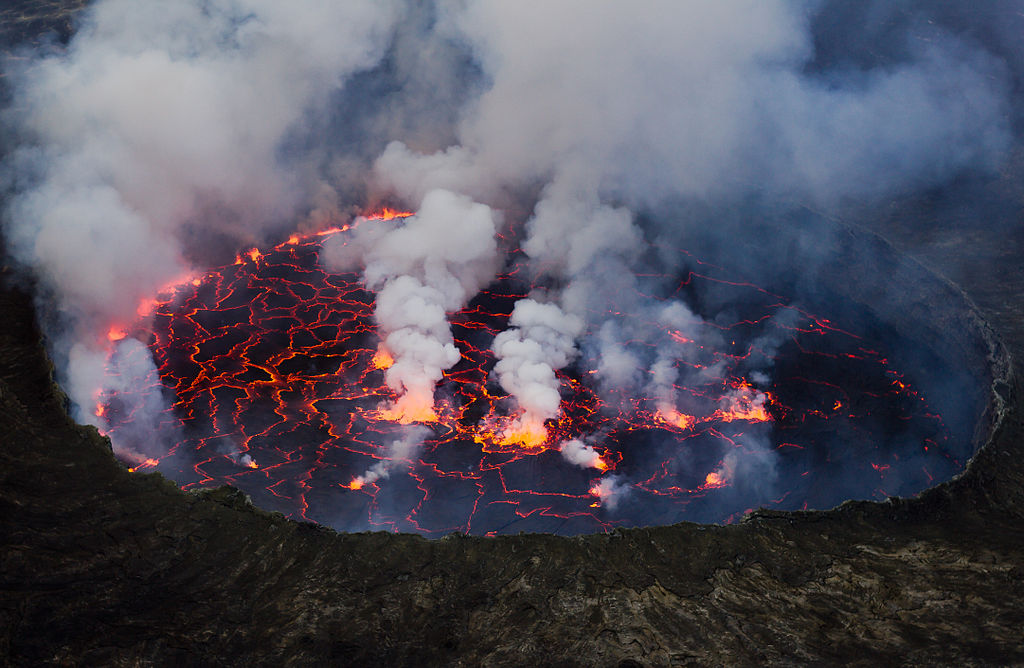Bill McGuire: Modelling suggests with ice cap melt, an increase in volcanic activity
He called for an early tsunami warning system and warned in his book The Waking Giant, of the Earth response (more earthquakes, tsunamis and landslides) to climate change.

Climate State interviewed Bill McGuire, Emeritus Professor of Earth Sciences at the University College London, one of Britain’s leading volcanologists and contributing author to the 2011 IPCC report.
He called for an early tsunami warning system (2004, The Guardian) and warned in his book The Waking Giant, of the Earth response (more earthquakes, tsunamis and landslides) to climate change.
Modelling suggests that as the ice cap continues to melt, so there will be a measurable increase in volcanic activity
Chris Machens: In your book Waking The Giant you mentioned (Excerpt) that prior to the PETM, huge amounts of magma flow onto the lands. Can we expect a similar response from the Earth crust with current and projected climate change, especially in light of what has become a chronic deglaciation event in the northern hemisphere? Is there a possibility for volcanic traps to emerge under current continental configuration (Related)?
Bill McGuire: The lava outpourings that occurred prior to the PETM were linked to large-scale tectonic events; notably the opening of the North Atlantic, which are not occurring today, so there is no reason to expect similar magma deluges in relation to contemporary climate change. It would be reasonable, however, to expect a response from active volcanoes that are buried beneath ice or that host a thick ice cover. Around 12,000 years ago, when the 1km-thick ice cover across Iceland largely disappeared, volcanic activity increased by 30 times over the course of a 1500-year period.
Ice cover on Iceland is now confined to the Vatnajokull Ice Cap, beneath which are the Grimsvotn, Eyjafjallajokull and Bardarbunga volcanoes, which have all erupted in the past four years. Modelling suggests that as the ice cap continues to melt, so there will be a measurable increase in volcanic activity. It is very unlikely, however, that this will be on the post-glacial scale, but it could lead to more eruptions than would happen otherwise, or bigger ones.
Elsewhere in the world, the loss of ice from high altitude volcanoes in places like Alaska, Kamchatka, the Andes, the Cascade Range could promote more explosive eruptions or flank collapse. Changing stress conditions around the ocean margins, as sea levels rise, may also promote eruptions at coastal and island volcanoes.
Environmental changes, such as pressure change is expected to trigger fault line rupture
Chris Machens: Since a lot of discussions evolve around the amount of CO2 in the atmosphere, is it yet possible to quantify projected seismic uptake in relation to particular emission scenarios, based on past events or modelling, or is this easier when comparing sea level heights?
Bill McGuire: It is not possible to link the level of seismic response to particular emissions scenarios in any meaningful way. This is because each active fault is in a different state of strain at any given time, so will respond in a different manner to stress and strain changes that accompany the loss of ice cover or increase in sea level. Where a fault is primed, however, its rupture may be triggered by a pressure change that is literally comparable to that exerted by a handshake. In such circumstances, the environmental changes promoted by climate change could be expected to provide such a trigger.
Chris Machens: When talking about geological hazards, underwater landslides are rarely mentioned. With subsea permafrost thawing and horizontal post-glacial rebound/glacial isostatic adjustment – the thawing of ice masses, should we expect something similar to the destructive Storegga Slide?
Bill McGuire: In order for major submarine landslides to form, there has to be available an enormous supply of unstable sediment. In the case of the Storegga Slide, this sediment had accumulated over a long period of time on the Norwegian continental shelf; brought down by glaciers and deposited when sea levels were depressed. As I understand it, analysis of the Norwegian shelf undertaken as part of oil exploration, suggests that there are no areas of unstable sediment that could be shed as a consequence of earthquakes or methane hydrate breakdown.
My concern, however, is that there may be a threat of submarine landslides around the margins of Greenland, which are less well explored. Greenland is already uplifting, reducing the pressure on the crust beneath and also on submarine methane hydrates in the sediment around its margins, and increased seismic activity may be apparent within decades as active faults beneath the ice sheet are unloaded. This could provide the potential for the earthquake or methane hydrate destabilisation of submarine sediment, leading to the formation of submarine slides and, perhaps, tsunamis in the North Atlantic.
Methane hydrate destabilisation is clearly a real worry, particularly in the context of warming ocean waters in the East Siberian Continental Shelf
Read also: With Few Data, Arctic Carbon Models Lack Consensus
Chris Machens: Since the water regime in the Arctic circle has changed due to freshwater uptake, and with progressing thaw of deeper layers, could this potentially impact the fault lines in the ESAS region too? Cope & Winguth 2011, suggested that freshwater input into the North Pacific could serve as a catalyst for methane hydrate destabilisation.
Bill McGuire: Methane hydrate destabilisation is clearly a real worry, particularly in the context of warming ocean waters in the East Siberian Continental Shelf. It is also a concern around Greenland, where uplift as the ice continues to melt seems likely to raise submarine deposits around the margins more rapidly than sea level increases, thus having the potential to cause destabilisation of methane hydrates contained therein as a consequence of reduced pressures. I don’t think, however, that warming is likely to directly affect the operation of any tectonic faults within the East Siberian Shelf itself. If anything, as sea levels continue to rise, submarine faults – in general – will become more stabilised beneath the increasing load.
We see evidence of the Earth ‘waking up’ specifically in relation to seismic activity in areas of Alaska
Chris Machens: Since the climate system involves many feedbacks, more volcanic activity would mean that the Earth responds to the warming, for instance because of increased precipitation patterns. You mentioned in your book that after the end of ice ages volcanic activity rose from two to six times above normal background levels. What kind of uptake is plausible today, and can we already see early signs of the Earth crust responding, is the giant waking up?
Bill McGuire: At the end of ice ages, the volcanic response is more powerful than any likely to arise due to current climate change, because many more volcanoes were ice covered and then responded to the loss of the ice by erupting. Today, as I mention in my answer to question one, there are far fewer ice-covered volcanoes than there would have been at the height of the last ice age. Nonetheless, a notable volcanic response may arise from coastal and island volcanoes as sea level rises, particularly if this becomes rapid in response to collapse of the Greenland and West Antarctic ice sheets.
As with a seismic response, however, the volcanic response will differ from one volcano to another (of the 800+ that are located in or close to the ocean); dependent on where the volcano is in eruptive cycle; e.g. if magma is available for eruption; if the magma pressures are already close to overcoming confining pressures and the strength of the overlying rock. Volcanoes that are critically poised will be ‘persuaded’ to erupt more easily than those that are not.
We see evidence of the Earth ‘waking up’ specifically in relation to seismic activity in areas of Alaska where dramatic ice loss (up to 1km vertical thickness) has occurred over the last 100 years, and also in relation to the correlation in many high mountains terrains of increased landslide occurrence and heatwaves.
There is no unequivocal evidence for a specific volcanic response, unless the high level of recent activity at the Icelandic volcanoes is a reflection of unloading due to melting of the Vatnajokull Ice Cap. Certainly this whole region is uplifting by a few centimetres a year, so such a suggestion would not be completely unreasonable, even if we don’t (yet?) have any hard evidence.
Any warning system is likely to be considered only after the event
Chris Machens: Are there plans or is there already a system in place, to monitor via remote sensing or buoys, such as the successful ARGO floaters, for changes and potential hazards in the northern hemisphere? At what point do we need a tsunami warning system for the Arctic/East U.S./Russia/Europe/Canada?
Bill McGuire: As far as I am aware, there are currently no plans for any tsunami warning system in the North Atlantic or the Arctic Ocean, and I would be very surprised if one was established. Even though climate change is ensuring that we are in a different ‘ball game’, the fact that tsunamis are extremely rare in the region is very likely to be used as an argument not to do anything. As is nearly always the case, and as we saw in the Indian Ocean in 2004, any warning system is likely to be considered only after the event.
Chris Machens: With over 90% of the heat from global warming ending up in the oceans first (OHC), are there any impact assessments done about this extra energy and what are the likely effects in regards to the geosphere?
Bill McGuire: The straightforward answer is no. Even though the ocean’s take up (luckily for us) a huge amount of the heat, the temperature deep down, where the sea is in contact with the crust remains virtually unchanged in many parts of the world. I think the main concern, in relation to ocean heating, has to be in the context of accelerating the melting of shallow, submarine, permafrost, and the greatly increased – as a consequence – risk of methane outbursts.
How can we attribute future earthquakes, landslides and volcanoes to climate change?
Chris Machens: Often it is not easy to attribute a certain extreme event to climate change, though it is now generally accepted that climate change literally puts any weather event on steroids (Related: [1], [2]) How can we attribute future earthquakes, landslides and volcanoes to climate change?
Bill McGuire: This is the big question and one that is not easy to answer. How can we say that a particular volcano would not have erupted anyway or a particular fault would not have ruptured in any case to trigger an earthquake? If there is a measurable rise in global seismic or volcanic activity then we could probably make a convincing case for climate change playing a role.
It is possible, however, that any response will take place on a more spatially-limited basis; affecting only certain volcanoes or faults, so there may not be any obvious, overarching, global signal. In such cases, it should be possible to model the changes in stress and strain driven by climate change parameters such as ice unloading or sea level rise and to evaluate their role in triggering an eruption or earthquake.
Chris Machens: Thank you for the interview.
Visit Bill McGuire’s website billmcguire.co.uk
Related
- Interaction between climate, volcanism, and isostatic rebound in Southeast Alaska during the last deglaciation
- Waking the Giant: How a changing climate triggers earthquakes, tsunamis, and volcanoes
- Iceland Is Experiencing Its Biggest Continuous Volcanic Eruption in Centuries (October 14, 2014)
- Subglacial and intraglacial volcanic formations in Iceland
